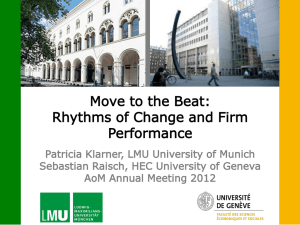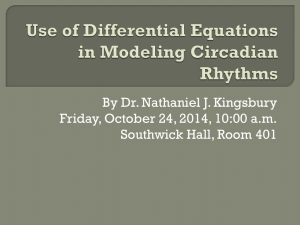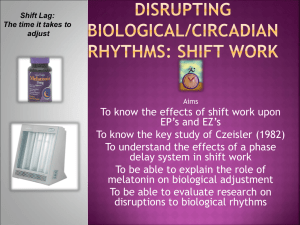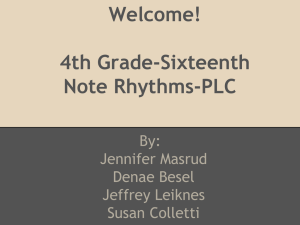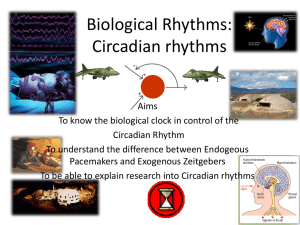biological rhythms (LRA) 2012
advertisement
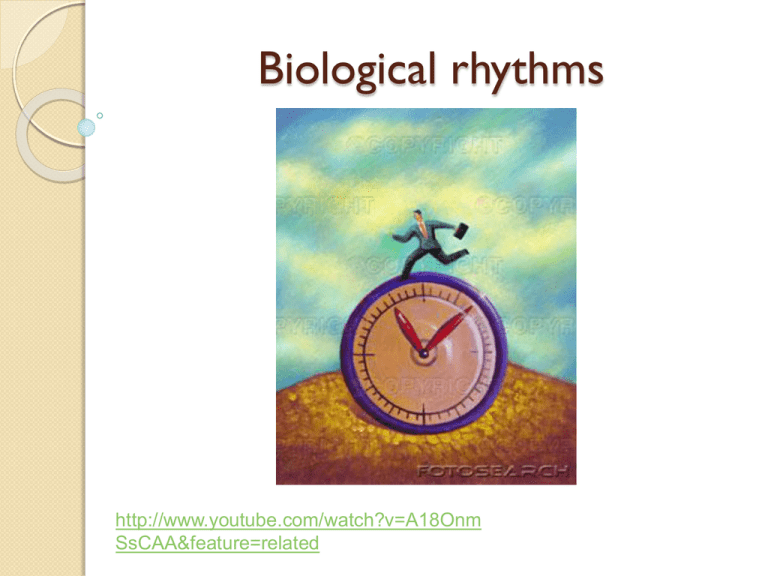
Biological rhythms http://www.youtube.com/watch?v=A18Onm SsCAA&feature=related Biological rhythms Regular variations in the biological activity of living organisms, such as sleep, body temperature, alertness, neurotransmitter levels, etc. Ultradian rhythms: less than 24 hrs periodicity Circadian rhythms: 24 hrs periodicity Infradian rhythms: more than 24hrs periodicity See page 2 – identify which rhythms Try experiment on page 3 Factors which affect biological rhythms Endogenous pacemakers: Biological ‘clocks’ in the brain controlling biological rhythms. Most likely the suprachiasmatic nucleus in the hypothalamus Exogenous Zeitgebers (Timegivers): External stimuli that help towards regulating biological rhythms to the outside world Think of some examples. Circadian rhythms Examples: sleep/waking, body temperature Circadian rhythms are needed to balancing behaviour and body states to environmental changes The Biological Clock – how does it work? The Biological Clock - How does it work? Thought mainly to be an endogenous (internal) mechanism Our internal rhythms are thought to be generated by protein synthesis within the SCN. Protein is produced for a period of hours until it reaches a level that inhibits further production. Over the next few hours the protein level gradually falls, when it drops to a certain ‘threshold’ level then production of the protein re-starts. This generates an internal (endogenous) biological rhythm – in humans of between 24 ½ and 25 hours. See textbook This endogenous rhythm is regulated to keep it in line with our environmental rhythms by an exogenous mechanism below: SCN have a nerve input directly from the retina of the eye, so they are kept informed about the zeitgebers of light and darkness. I The Pineal Gland Important pacemaker in birds and reptiles. Lies just beneath the bone of the skull & receives info about light. Many lizards have a ‘third eye’ near the pineal gland, which protrudes through a small opening in the skull. In darkness this information is transmitted to the pineal gland which manufactures melatonin a hormone which stimulates the production of serotonin in the raphe nucleus. This hormone causes reduced levels of arousal and so induces sleep. 1) Darkness Falls 2)Optical Chiasm 3) Stimulates SCN 4)Stimulates Pineal Gland 5) Produces Melatonin 6) Produces Seratonin 7) Brain Activity Falls 8) Sleep When Light enters through the eyes it stimulates the SCN to produce an inhibiting factor (probably a protein) This inhibits the production of melatonin by the pineal gland and so maintains arousal levels – keeping you alert and awake! Answer questions on page 8-9 Test Explain how one exogenous zeitgeber affects the sleep/wake cycle What type of rhythm is the sleep/waking cycle? Explain why the pineal gland is an important part of the biological clock? Explain why the mechanism for birds/reptiles and humans/mammals is different. Give an example of an ultradian rhythm Siffre study Michel Siffre in 1972 went to live in a cave for 6 months. When he was awake the lights in the cave were on, when he went to bed the lights were off. His sleep/wake cycle regulated between 25 and 30 hrs (more than 24 hrs). When he reached the 179th day, his days were only 151 since he started living underground Morgan (1995) Bred mutant hamsters so they had circadian rhythms of 20 instead of 24 hours. He transplanted their SCN into normal hamsters. The normal hamsters displayed the ‘mutant’ rhythm. What does this provide evidence of? Miles et al (1977) Miles et al’s (1977) study of a blind man. The man blind from birth had a circadian rhythm of 24.9 hours. He had to use stimulants and sedatives to adjust his sleepwaking cycle to the standard 24 hours. This shows that light is the main exogenous factor, as it reduces the natural 25 hour rhythm to 24 hours. Evidence - The Role of Melatonin Schochat et al’s “Sleep gate” study (1997) found a close relationship between sleep propensity and melatonin. Six participants spent 29 hours in a sleep laboratory where for 7 minutes in every 20 they had to try to sleep. The highest sleep propensity, the “sleep gate” was found to occur in late evening and the highest levels of melatonin preceded this by 100-120 minutes. But this study only shows a correlation! Infradian rhythms Occurring to a period more than 24 hrs, such as the human menstrual cycle Some of them may take place on a yearly basis and they are known as circannual rhythms, such as the migration of birds, and hibernation in squirrels bears, and hedgehogs The Menstrual Cycle -an example of an Infradian Rhythm, is controlled by hormones oestrogen and progesterone Menstruation is an endogenous rhythm but similar to the sleep wake cycle research has shown that it can be affected by many exogenous cues. – RESEARCH :- A woman who spent 3 months in a cave developed a shortening of her menstrual cycle which took some time to revert back to normal once she emerged (Reinberg, 1967) Infradian rythms Menstruation in the absence of Zeitgebers: It has been observed that menstruation starts mainly in winter (for the first time), and that because the pineal gland is affected by the melatonin’s secretion and the reproduction system in general (conceptions in lighter months) (Reinberg, 1967) Russell et al 1980 found that pheromones – biochemical substances that act like hormones but are released into the air can have the effect of synchronising a group of women’s cycles upon repeated exposure to one another. McClintock (1971) synchronised cycles through pheromones of other women & synchronised cycles through pheromones of men Infradian rhythms Seasonal affective disorder (SAD): Seasonal changes in behaviour can also be found in human beings. Individuals feel depressed during winter, and elated during summer. One suggestion is that absence of light increases melatonin, and what is suggested is light therapy (Rosenzweig et al., 1999). As an example, depression is mostly seen in northern than southern countries instead Ultradian rhythms Shorter than 24 hrs, such as smoking, eating and drinking, renal excretion (discharging waste through kidneys), sleep (different stages studied through EEGElectroEncephalography), etc. (Loomis et al., 1937) Ultradian rhythms (Recording Sleep) EEG (Electro-EncephaloGraphy): It measures and records the electrical activity in a person’s brain EOG (ElectrOculoGram) it records eye movements during sleep EMG (ElectroMyoGram) it records muscle activity during sleep Test Outline what is meant by an endogenous pacemaker Why is the hormone melatonin important? Briefly describe a study about a ‘free-running’ biological rhythm and what was found. Describe the findings of Russell et al’s study into mentrual cycles. Explain how an exogenous zeitgeber influences the mentrual cycle. Luce and Segal Artic Circle study (1966) People who live within the Artic circle sleep for 7 hours per night despite the fact that during the summer the sun never sets. This shows that light is not the only zeitgeber, nor is the biological clock only influenced by light. Other exogenous factors such as social customs and psychological factors Kleitman (1963): Student partcipants went to live to an underground bunker, with no cues of light or dark. They had to choose their own sleep/wake times. Their circadian rhythms were extended between 25 to 27 hrs Evaluations Individual differences: Biological rhythms do not operate the same in all people, or in subjects of different parts of the world Number of participants: Because most of the research was carried out with single participants, the findings are generalised with great care Description Term Rhythm over course of 24 hrs Rhythm more than a day Rhythm less than a day Internal factors affecting rhythms External factors affecting rhythms Exogenous Zeitgebers Endogenous pacemakers Ultradian Infradian Circadian Check Key terms Test What three things are measured in studies of sleep cycles What did Luce and Segal’s research suggest about Zeitgebers? Suggest some possible methodological criticisms of research into biological rhythms How do we know that free-running sleep cycles are different the normal 24 hrs? Disrupting biological rhythms Jet lag Travelling to different parts of the world for some days after the journey the sleep/wake cycle is disrupted (body temperature fails/body arousal may increase or decrease) Shift work Employees required to a shift work, normally go to sleep when others are awake. When biological rhythm is disrupted (endogenous pacemakers/exogenous zeitgebers), sleep/wake cycle is disrupted too Consequences Stevens (2006) Artificial lighting may cause disruption to biological rhythms which was not accounted for in some studies e.g Siffre. Decreased Melatonin levels is associated with cancer. This may explain why breast cancer is more common in western countries where exposure to artifical lighting is greater. Coren (1996) argues that because of all those changes in our lives we end up sleeping 11/2 less than in a century ago Consequences There are a range of consequences associated with a lack of sleep including Poor decision making (see incidents on page 18) Same affect on driving as alcohol (DeWaard and Brookhuis 1991) Female flight attendants performed poorly on attention tasks compared to grounded colleagues (Cho et al, 2000) Evaluation of research on disrupting biological rhythms Research findings Disrupting our biological rhythms has cognitive and emotional effects, as well as drastic consequences Methodological issues Studies have great ecological validity, however personality and individual differences are not controlled in those studies. Most are correlations e.g between shift work and road accidents ?? Write a shocking news article ! Write the article to inform the public about the dangers of shift work and jet lag to our health. You may wish to go to the library and investigate accidents which have occurred during the night when workers are on night shift! Recap Complete gap fill page 19 Test Explain the affect of artificial light on biological rhythms. Explain the affect of lack of sleep on driving ability. Suggest a study which supports the idea that shift work results in poor performance. What affect does SAD have on melatonin levels?

